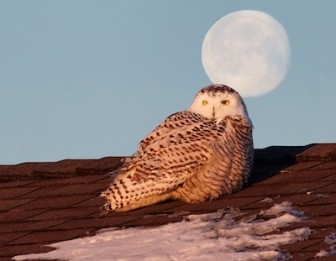Great Lakes area birdwatchers might keep their eyes peeled for snowy owls next month as part of the 18th annual Great Backyard Bird Count.
Researchers say the bird should be visible further south than its usual Canadian winter habitat.
Last year bird enthusiasts in the U.S. were delighted to see the large white owl, which usually stay in Canada before spring migration, but were spotted as far south as Oklahoma and Florida, said Pat Leonard, a writer at the Cornell Lab of Orinthology in Ithaca, N.Y.
The increased U.S. spottings are a result of a growing snowy owl population in the Arctic Circle, making younger birds branch into other regions to find food.
The bird counting will occur Feb. 13-16. The effort encourages anyone anywhere to count birds for at least 15 minutes on one or more of the days. Counters then enter their sightings at the event’s website. The Cornell lab is one of the organizations in charge of the bird counting project.
“It began as an experiment to get a quick snapshot of where birds were before migration,” said Leonard. “It started small but grew year by year, and then in 2013 we went global with the project.”
Since becoming global, the project has documented birds in more than 135 countries, including India, Australia and Mexico, Leonard said. The project identified more than 4,300 different species last year, more than 40 percent of the species in the world.
“If people don’t have their own feeder they can still count the birds in their backyard, or in a neighborhood that may have berries or seeds on trees and shrubs that birds are attracted to or they can visit a local park or nature center and participate from there,” said Agatha Szczepaniak, public relations contact from the National Audubon Society.
Last year, watchers in Michigan submitted more than 4,000 checklists during the count, a new state record. They reported more than 120 species of birds. The Great Backyard Bird Count rankings by country, state and county can be found here.
Great Lakes region residents will be able to spot blue jays, robins, chickadees, titmice, downy woodpeckers, red-bellied woodpeckers, juncos and nuthatches, according to Szczepaniak.
The information gathered during the bird count goes into a database to help researchers understand bird population patterns before spring migration. Pattern identification helps them recognize large-scale and far-reaching questions such as how climate change or West Nile virus affects birds, Szczepaniak said.
The Great Backyard Bird Count also runs a photo contest with the event. Last year bird lovers submitted more than 4,000 photos which were judged in six different categories.
Participation in the count and the photo contest is free. Interested readers can find how to join the count and enter the photo contest on the Great Backyard Bird Count website.
The Great Backyard Bird Count is sponsored by Wild Birds Unlimited and is a joint project of the Cornell Lab of Ornithology,the National Audubon Society and Bird Studies Canada.

